An Introduction to Buddhism, Jodo Shinshu and a Brief History of the San Jose Buddhist Church Betsuin and the Organizations of the Betsuin
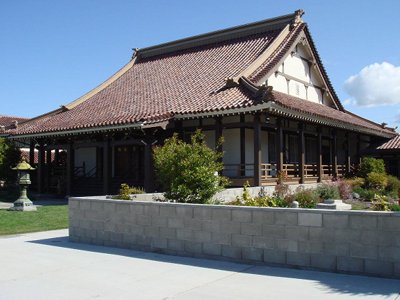
Hondo (Main Chapel) completed 1937
Welcome to the San Jose Buddhist Church Betsuin. The San Jose Buddhist Church Betsuin serves its members throughout Santa Clara County including Morgan Hill and Gilroy as well as some members in neighboring counties.
The San Jose Buddhist Church Betsuins main temple is located at 640 North Fifth Street in the Japantown section of Central San Jose. Our temple is part of the Buddhist Churches of America (BCA) headquartered in San Francisco, California. The BCA, in turn, is affiliated with the Jodo Shinshu Hongwanji-ha (Nishi Hongwanji) in Kyoto, Japan. In America the term Betsuin refers to a special status accorded to certain temples of particular historic or geographical importance. This status was accorded to the San Jose Buddhist Church in 1966.
Our telephone number is (408) 293-9292 and our fax number is (408) 293-0433. Email:[email protected]
Our Betsuin belongs to the Jodo Shinshu Hongwanji-ha (The sect of the True Essence of the Pure Land tradition, Shinshu). Our doctrinal founder is Shinran Shonin (1173-1262), who lived during the Kamakura Period of Japan. He was given the posthumous title of Kenshin Daishi (the Master who saw the Truth) by Emperor Meiji. A statue of Shinran Shonin is located at the front of the temple.
The history and development of the San Jose Buddhist Church Betsuin is deeply connected with the history and development of the Japanese-American community that settled in the Santa Clara Valley at the end of the nineteenth century.
The temple served as a religious and cultural center in the lives of those early pioneers, the Issei.
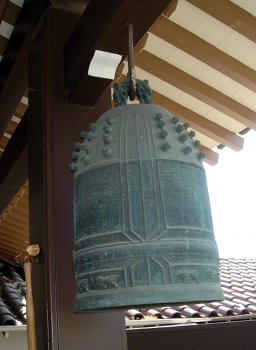
Hondo Bell

Lantern (toro)
Today, our temple continues to play an active role in the lives of the descendants of those pioneer immigrants as well as in the lives of the wider multicultural community that the temple has come to serve. A diverse ethnicity can be seen on any given Sunday.
Hopefully, this pamphlet will give you a glimpse into our temples activities as well as an appreciation for those who sacrificed and dedicated so much in the establishment of our temple.
The Three Treasures
There are hundreds of sects and denominations of Buddhism in the world. One common thread that ties them together is the Three Treasures or Threefold Refuge, of Buddha (the Awakened One), Dharma (the Law or Truth, i.e., the Buddhas teachings) and Sangha (the Buddhist order). A Buddhist is one who takes refuge in these three treasures. To better understand our denomination and place within the world Buddhist community, a Jodo Shinshu perspective of the Three Treasures (Buddha, Dharma and Sangha) follows.
Buddha
Buddha is a title given to an enlightened being, an individual who has awakened to the truth of the universe. Therefore, the word Buddha is usually translated as enlightened one or awakened one. There are hundreds of thousands of Buddhas or, as is often said, as countless as the sands of the Ganges. The founder or rather discoverer of the teachings of Buddhism is the historical Buddha, Sakyamuni Buddha.
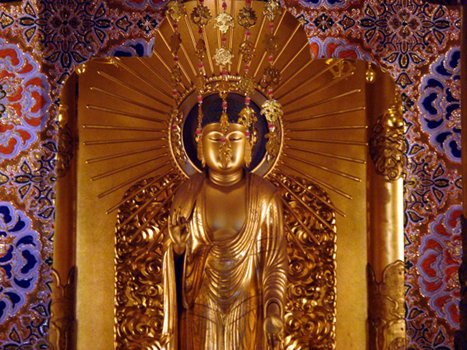
Amida Buddha
Sakyamuni Buddha was born in India about twenty-six hundred years ago as Prince Siddhartha Gautama near present day Nepal. The Prince was born into a life of material comfort. Over time, he became troubled when he witnessed the suffering that human beings must endure in this world of life and death regardless of position or status.
Those sentient beings fortunate enough to be born as human must suffer birth, old age, sickness and death. We suffer when separated from loved ones, when meeting those we do not care for, when not getting what we seek and the pain accompanying the changes of ones mind and body through maturity and aging. These are known as the eight sufferings. At the age of 29, Siddhartha Gautama left his kingdom, wife and family to find freedom from his existential suffering. For six years, he searched and studied under many different teachers, undertaking severe physical and mental ascetic practices. It is said that he mastered all of the various disciplines, yet could not find spiritual liberation through these paths.
As a result of his dissatisfaction, he gave up these practices and strengthened himself in mind and body. He then sat under the Bodhi Tree, vowing not to leave until he had discovered the way to spiritual freedom. During his meditation, the principle of dependent origination, or interdependence dawned on Siddhartha. In other words, he came to see the interdependence of all things in the Universe. He eventually awakened to the causes and cure for the existential suffering of man. The cure he found was the path of spiritual freedom, which is now known as Buddhism, the path to Buddhahood or enlightenment.
Siddhartha Gautama came to this awakenening and became the historical Buddha, Sakyamuni, at the age of thirty-five. We celebrate this event on December 8, as Bodhi Day.
Dharma
As stated earlier, there have been thousands of individuals who have awakened to the Truth. That which distinguishes the Sakyamuni Buddha can be seen in examining the next two treasures, Dharma and Sangha
Within the Dharma and Sangha we find the personal significance to the path of freedom, discovered or rediscovered by Siddhartha Gautama. After his enlightenment, Sakyamuni Buddha personally stated that what he discovered was nothing new. The Truth had always been in existence. He had merely rediscovered it. Through the Dharma and the acceptance of this Truth as a result of personal introspection, the Dharma came to life.
After his enlightenment, Sakyamuni Buddha was not sure that this path to freedom could be understood by all mankind. He felt that mans attachment to the ego was so strong that it would be virtually impossible to break from the bonds of self-centeredness and to realize, true compassion.
The legends state that as he was contemplating whether or not to share the fruits of his enlightenment, two merchants, Tappussa and Bhallika, came and expressed their reverence towards him. Standing to one side they said, O Bhagavat, we request you accept this offering of wheat cake and honey cake on our behalf and help us attain peace and lasting benefit. The two merchants then prostrated themselves at his feet by touching their foreheads to the ground and stated, Here we pledge our homage to the venerable master and Dharma. O venerable one, please receive us as lay followers. From this day hence until the time of our death, we shall pay homage. This was the first identification of the Buddha and Dharma, the first two of the three treasures. With this incident as proof of humanitys potential to learn and benefit from his teaching, Sakyamuni Buddha traveled to Deer Park to share his discovery with the five fellow seekers who were still practicing the ascetic rituals that he had given up.
The content of this first sermon given by the Sakyamuni Buddha to his five companions is known as shiten borin setting the wheel of Dharma in motion. The contents of this sermon can be summarized as the Four Noble Truths. (1) Life is suffering, as expressed in his first concerns of the eight suffering, which had lead him to begin his search. (2) This suffering is caused by our attachment to ego. The desire that the changing will become unchanging causes suffering. (3) It is possible to gain freedom from this suffering. If we can understand the true nature of ourselves and see the cause of our attachment to ego, we can find liberation from this cycle of suffering. (4) The Eightfold Noble Path is the process to transcend this cycle of suffering. The path is composed of Right View, Right Thought, Right Speech, Right Conduct, Right Livelihood, Right Effort, Right Mindfulness, and Meditation.
After hearing the Sakyamuni Buddha extol this teaching, each of his companions came to realize enlightenment. They took vows to follow the Sakyamuni Buddha and to share their understanding with others. This is traditionally viewed as the beginning of the Sangha, the Buddhist order.
For the next forty-five years, the Sakyamuni Buddha continued to teach the Truth that he awakened to under the Bodhi Tree. In the Mahaparinirvana Sutra, it is written that at the time of the Buddhas death, he told those gathered, after my death, the Dharma will be your teacher. Throughout his life the Buddha stressed the flow of wisdom and compassion as a dynamic activity reaching out to embrace each of us. Without the Dharma, and Sangha, at the time of the Sakyamuni Buddhas death, this compassionate flow of the Truth may have stopped. However, with the Dharma as our teacher, this compassionate flow continues to reach out and embrace each and every one of us.
Over those forty-five years of teaching, the Sakyamuni Buddha spoke of the Truth to which he had awakened under the Bodhi Tree. His method was to teach the Truth in such a manner that each individual would understand the Truth according to their individual capacity. After his death, these teachings were compiled, interpreted, and eventually became the foundation stones upon which each of the various denominations and sects of Buddhism developed their various practices. This compilation is known as the Tripitaka (Three Baskets). Although each particular denomination or sect may emphasize a certain aspect or interpretation of the Dharma, the first sermon by the Sakyamuni Buddha becomes the starting point of each.
Our Jodo Shinshu tradition bases its teachings upon the Larger Sukhavativyuha Sutra, the Meditation Sutra and Amida Sutra. These three sutras are collectively referred to as the Jodo Sanbukkyo (Three Pure Land Sutras).
Jodo Shinshu
Shinran Shonin, the founder of our sect of Buddhism wrote in one of his poems, The true intention of the Tathagata (Sakyamuni Buddha) in coming to this world is to present the truth of the Original Vow. Shinran Shonin struggled for 20 years at the Tendai Monastery located on Mt. Hiei as a monk in that tradition. During his lifetime and for many years before and after, Mt. Hiei was the central institution of Buddhism in Japan. Almost all major sects of Japanese Buddhism can be traced to Mt. Hiei. While on Mt. Hiei, Shinran studied and practiced the prescribed Buddhist rituals which he believed would lead the follower to enlightenment. However, over those twenty years of practice and study, Shinran did not find his way to spiritual freedom.
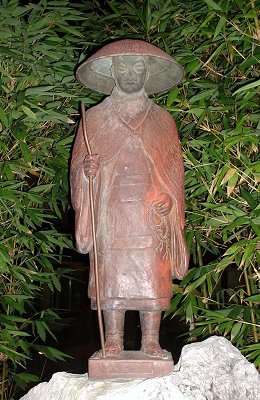
Shinran Shonin (1173-1263)
In his quest for a path to spiritual emancipation, Shinran came to hear about his future teacher, Honen. Honen, also known as Genku, had studied on Mt. Hiei and had abandoned the monastic life style to spread the teaching of the Nembutsu. Honen saw the Nembutsu as being the way for common people to find spiritual emancipation. Up until this time, the Buddhist teachings were reserved for those who left their families and took precepts to become monks or nuns. In Honen Shonin, Shinran found a teacher (Zenchishiki), who would guide him on the path to his religious liberation.
After years of study and reflection, Honen Shonin selected the 18th vow among the 48 vows in the Larger Sukhavativyuha Sutra established by Amida Buddha when still the Bodhisattva Dharmacara as the path for spiritual liberation and eventual enlightenment for the common person. The 18th vow stated, When upon obtaining Buddhahood, all the beings in the ten quarters who, with sincerity of heart, hold faith and wish to be born in my country, repeating my name up to ten times, are not so born, I will not attain the Highest Enlightenment. Excluded only are those who committed the five deadly sins and those who have abused the true Dharma. Through Honen Shonins guidance, Shinran understood that the way to his own spiritual freedom was not through his calculated efforts but through the working of Amida Buddhas vow power (ganriki). He constantly worked to lead all sentient beings to enlightenment.
At the instant of this realization, which Shinran called shinjin, he knew that the self-powered practices (jiriki) towards enlightenment were not paths that were effaceable for him. It was through the working of Amida Buddhas vow that his salivation was established and possible. As a common foolish being (bombu) in the age of the Decadent Dharma (mappo) his basic nature, characterized by greed, anger and ignorance (bonno) was such that his ability to attain enlightenment was severely limited. Yet, through the wondrous working of True Compassion and True Wisdom, directed to him by Amida Buddha as promised in the 18th vow, (other power, tariki), he was assured of attaining enlightenment. Through entrusting oneself to Amida Buddha and the recitation of Amidas name, which comes to sentient beings as the Nembutsu, Namo Amida Butsu (entrust oneself to Amida Buddha), any and all beings could attain enlightenment just as Sakyamuni Buddha and Amida Buddha before him. This realization is called shinjin and is the central focus of the Jodo Shinshu Teaching.
To live a life of gratitude is often said to be the Jodo Shinshu way of life. This expresses our gratitude to the countless causes and conditions that have come together to enable us to hear the teachings of Jodo Shinshu. The practice of Jodo Shinshu is to hear the teachings (Monpo). This life of gratitude is based upon the power of Amida Buddhas vow, extended to all sentient beings, whether high or low born, monk or laymen. This expresses the Universality of the Jodo Shinshu way of life. This view leads us into the Jodo Shinshu view of the third of the three treasures, the Sangha.
Sangha
As mentioned in the account of the Sakyamuni Buddhas meeting with the two merchants, Tappussa and Bhallika, they encouraged the Buddha to share his teaching with all of us.
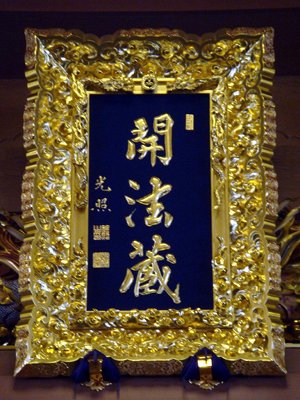
Kai Ho Zo (Open Dharma Storehouse)
However, traditionally, Tappussa and Bhallika would not be considered to be a part of the Sangha. The Sangha was limited to the fellowship of Buddhist monks and nuns. Therefore, Tappussa and Bhallika, householders and merchants, would have been excluded. From a very orthodox view of the Sangha, it is only with the Sakyamunis preaching to his five friends and their acceptance and decision to join Sakyamuni Buddha, that the Sangha was established.
It was a prerequisite to give up home and family and adhere to the precepts as a monk or nun to be counted amongst the Sangha. Up to the time of Honen Shonin and even today, in some schools of Buddhism, enlightenment is only possible for those who had renounced their life in society and become monks or nuns.
However, with Honen Shonin and Shinran Shonins break from the monastic tradition of Mt. Hiei, a new view of the Sangha developed. Through the development of the Jodo Shu and Jodo Shinshu doctrine, enlightenment was made accessible to the lay follower. Tappussa and Bhallika had venerated the Buddha many centuries earlier, but lay followers were not considered to be a part of the Sangha. It was a result of the Nembutsu teaching, that Enlightenment for everyone became a reality. Shinran has written, Amidas Primal vow does not discriminate between the young and old, good and evil; true entrusting alone is essential.
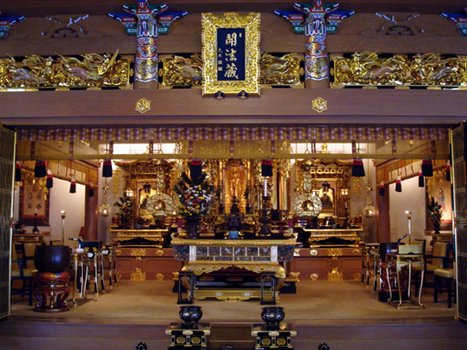
Onaijin (altar) donated in 1928
From a Jodo Shinshu standpoint, the Sangha would encompass all the followers of the Nembutsu path. In one of Shinrans letters, he wrote, All those who listen to the Nembutsu teachings are equal, we are all fellow travelers, reverently following the path, the hearts of those who believe in Jodo Shinshu are the same. With this view, the Sangha of our Betsuin encompasses all who walk this path, blazed by Sakyamuni Buddha over 2600 years ago.
A Short History of the San Jose Buddhist Church Betsuin

Oldest tree on property
The San Jose Betsuins colorful origin can be traced to the early Issei pioneers who immigrated around the turn of the Twentieth century. The temple began in August of 1902 when ministers journeyed from San Francisco to San Jose to conduct Buddhist services. Earlier, the San Jose Church was a branch of the San Francisco Church.
The first temple was constructed in 1907 when Reverend Honen Takahashi was our first resident minister. Over thirty-four ministers have served the Temple in the 90 years of history. Our current temple was completed in 1937, and continues to serve our Sangha.
A compassionate attorney, J.D. Peckham, took care of our temple during the war years as most of the Japanese and Japanese-Americans were interned (1942-5). Following the release of the interned Isseis and Niseis from various relocation camps, the facilities of the gym and annex buildings served as temporary housing for them. Our temple has expanded due to the increasing need to accommodate the growth of our racially mixed and multi-cultural Sangha. A recent purchase of a Chinese Church on 6th Street property is such an example.
Today, the Sangha has reached a membership of approximately 1000 families. This temple draws members primarily from residents in central and southern Santa Clara County and members in outlying area. We belong to the Coast District of the BCA.
The Board of Directors and the resident ministers administer the business and operation of the temple. The kumon (elders) serve as advisors.
For a detailed history of our temple, the Archive Committee has records and artifacts for you to examine in the Archive Room.
Betsuin Membership and Dues
Membership is open to all interested in our temple and Jodo Shinshu teachings. The dues are used for the operation and maintenance of our temple. There is a pledge method to pay dues.
The board meets on the first Thursday of each month. Any sangha member in good standing is eligible to be nominated for a position on the board.
Ministerial Services
Our ministers at the Betsuin offer religious services and as well as general counseling services for Sangha members. The ministers are actively involved with the various organizations of our temple and serve as advisors.
Betsuin ministers offer services as follows:
- Individual and family counseling to aid in spiritual understanding when encountering issues of death and dying or other life-critical events in the course of life.
- Conduct study classes to promote Buddhist education and understanding.
- Wedding services to include planning and preparation.
- Memorial services
- Visitations to ailing Sangha members
- Propagation of Buddhism by speaking to various groups (when time permits).
Temple and Affiliated Organizations
Our temple has a variety of organizations as well as affiliated organizations. We hope you will consider joining one of the organizations. You will have the opportunity to meet new people and get involved in activities of the temple. The following is brief description of some of the organizations.
Dharma School
Dharma School provides Buddhist education for a wide range of age groups. The classes range from pre-school to high school. Dharma school provides basic education in Buddhism and Jodo Shinshu. A recent motto is, Attitude is gratitude. Registration is held in September. Any child (four years of age and older) is welcome to enroll and attend Dharma School. Basically, Dharma School is open from September to June.
The Dharma Schools media center is available to all sangha members. The center has many Buddhist books, videos and other related material.
Dharma School service is held at 9:30 AM, and the children immediately go to their respective classrooms at 10 AM. Most classes are across the street from the hondo. Cross guards from the Dharma School Parents Organization (DSPO) assist students across the street. Classes are dismissed at 11 AM.
Buddhist Womens Association
The Buddhist Womens Association (BWA) was commonly referred to as Fujinkai. Originally, composed of married women, they play a very active role in many facets of our temple life. Today, the composition has changed. Nisei and Sansei women, married and single, are taking an increasingly greater role. However, the legacy of the Issei women remains. They conduct a number of fundraisers. That essentially means they make and sell delicious food items throughout the year. We marvel at their energy level and their hard work.
Many BWA members are mothers and grandmothers who encourage and assist their respective family members to understand the Dharma through their participation in religious and program activities
Adult Buddhist Association
The Adult Buddhist Association (ABA) was formerly known as the Nisei Buddhist Association. As our Sangha has become more diverse, the name was changed. ABA is very active in religious and social activities, and they serve as a support group to other organizations. They participate in fundraisers during the Obon by manning one of the booths. They also conduct an annual rummage sale that is well attended by the whole community.
Junior Young Buddhist Association
Junior Young Buddhist Association (Jr.YBA) is both a religious and social organization for our high school age members. They meet on the first Sunday of the month usually after Dharma School. The Jr. YBA provides a constructive outlet for the youth and plan many enjoyable activities. They meet annually with youths from other temples.
Betsuin & Jr. Choirs
The San Jose Buddhist Church Betsuin Choir is the adult choir for the temple. They sing at the major Buddhist services, Hoonko, Hanamatsuri, Obon and other special events. The choir practices for up three months prior to a performance. Practices are held on Tuesday evenings. All members are welcome to spread the dharma through music. If you enjoy singing, having fun, meeting friends, and good food, join the temple choir. There are no auditions.
The Junior Choir meets weekly during the regular school year. They perform for Bodhi Day and Hanamatsuri service. They also have an annual recital held in the spring. It is a special treat to hear them perform. Registered Dharma School students in 4th grade through high school are welcome to join. There are no prerequisites or auditions.
Performance tours have taken place every 2 to 3 years. The Junior Choir has traveled to Hawaii, Orange County and Japan. Various fundraisers are held during the year to help fund the trips.
Sangha Support Committee
The Sangha Support provides support to our members. Support is provided by visitations and by sending get-well cards. Workshops and activities on various topics are scheduled on a monthly basis.
A segment of this group has developed into Sangha Crafters. They provide blankets, quilts and other items to community agencies and shelters.
Dana Club
This group is a community action group that is composed of Sangha members. They participate in various activities for the good of the community.
Archives Committee
The Archive Committee collects, sorts, and categorizes historical and current data as well as records, photographs, newsletters, artifacts and other information. These are available for research and study.
Study Groups and Classes
As there is a growing interest in Buddhism and Jodo Shinshu, the temple provides study groups and classes for anyone interested. Everyone is welcome to attend, and there are no prerequisites. Your level of knowledge is immaterial. These groups allow for question and answer periods, and the setting is informal and friendly. There are sessions throughout the month. There are day and evening classes, but please check with the temple office for specific dates and times.
Japanese Language School
The language school teaches basic conversation, vocabulary and Japanese culture to children five years or older. Classes are divided into groups for beginners, intermediate and advanced. Classes are held on Saturday mornings from September to June.
Scout Programs
Many of our Sangha families have their children in one of the scout programs. The meetings for the various scout groups are held on the temple grounds. The names and relative age groups vary. The scout groups listed below.
Daisy Troop 273 kindergarten age girls. Brownie Troop 1052 girls in 1sr to 3rd grade. Junior Girl Scout Troop 260 - girls in 4th to 6th grade. Cadette Troop 404 girls in 7th to 9th grade. Senior Girl Scouts girls in 10th to 12th grade.
Tiger Pack 611 boys in 1st grade. Wolf Pack 611 boys in 2nd grade. Bear Pack 611 boys in 3rd grade. Webelo Pack 611 boys in 4th and 5th grade. Boy Scout Troop 611 boys 6th grade and up.
Venture Scouts Crew 611 is for youths ages 14 to 20.
The scout groups assist in many of our activities and fundraisers by providing manpower for setup and cleanup. Several of the scouts earn the Eagle Scout Award which requires special projects.
Lotus Preschool
The preschool operates on the temple grounds. They participate in daily Buddhist services. The school has been in operation since 1987.
Nokotsudo (Columbarium)
The nokotsudo is a special area for the storage of ashes of loved ones. The nokotsudo was built and assembled by volunteer members of the temple. Funding was provided by generous donations of Sangha members. There are two types of placements. One is the shelf type where the urn is placed next to each other. The other type is where urns are placed in individual niche. There is an altar within the nokotsudo where family members may offer incense and flowers in a quiet setting. The present nokotsudo was completed in 2005.
Morgan Hill Buddhist Community Center
The Morgan Hill Center is a satellite of the San Jose temple, and their temple was completed in 1967. Many of the families in that area were instrumental in the fundraising project for the temple. An annual event, Haru Matsuri Festival, is held each year in April. They are located at 16450 Murphy Avenue, Morgan Hill, and their phone number is (408) 779-9009.
Scholarship Programs
Scholarships are available for high school graduates as well as students enrolled in college. Applicants are screened by a committee that focus on grades, community, school and temple involvement.
Scheduled Services
The Betsuin holds weekly services on Sundays from September to June:
- 9:30 AM Dharma School Service
- 10:10 AM Adult English Service
- 2:00 PM Japanese Language Service
Through summer:
- 10 AM English/Japanese Service with 2 groups divided for discussion with a minister.
Morgan Hill Buddhist Community Center (Sept-June)
- 9:30 AM - Dharma School Service
- 9:30 AM Joint Howakai/Dharma School, Service on 1st Sunday
Special Observances
The actual date of the observance usually falls on the closest Sunday.
January 1st - New Years Day Service (Shusho-E) or gathering to Practice the Correct Path. It is a time to renew and reaffirm our ties to the Nembutsu teachings as well to our families and Sangha members.
January 16th - Shinran Shonins Memorial Service (Goshoki Hoonko). It is held to acknowledge our gratitude to Shinran Shonins teachings of the Nembutsu.
February 15th - Nirvana Day (Nehan-E) to commemorate Buddhas death and entry into nirvana.
March Vernal Equinox - Spring Ohigan (Shunki Higan-E) is the spring observance of gathering Other Shore. It coincides with the equinox of spring and fall. The other shore refers to the shore of enlightenment as opposed to this shore of samsara (life and death). It is the power of Amida Buddhas vow that allows us to transcend this world to the world of enlightenment. It is the power of Amida Buddhas vow that allows us to transcend this world to the world of enlightenment.
April 8th Hanamatsuri (Flower Festival) and Kanbutsu-E (Bathe Buddha Gathering). This is the day we celebrate the birth of Sakyamuni Buddha. Legend tells us that when Sakyamuni Buddha was born in Lumbinis Garden, the entire garden was in full bloom. At his birth, sweet rain fell from the sky, and the earth shook in six directions. We celebrate the birth by bathing an image of the baby Buddha with sweet tea. The baby Buddha is enshrined in a Flower Shrine (hanamido) that is decorated with many colorful flowers.
May 21st Shinran Shonins Birthday (Shuso Gotan-E, Sect Founders Birth or Fujimatsuri or Wisteria Festival). We celebrate Shinran Shonins birthday. It is also called Fujimatsuri in reference to the flower that represents our sect. The wisteria is symbolic of Jodo Shinshu in that unlike other flowers that seem to stand up straight and tall in full blossom, the wisteria hangs down, as if in humility when in full bloom. This teaches us that a true and real human being does not stand up in arrogance at their accomplishments, but rather realizes that they have so much to be grateful for.
In connection with this observance, the Betsuin holds a Shosanshiki or Infant Presentation Service (first visit ceremony). This service is held for all the new born children born to the Sangha over the past year. It is a day to present the child to Buddha and to the Sangha, and to celebrate their first step upon following the Dharma.
June - Bishops Memorial or Shochoki. A service is held in June in memory to all the past Bishops of the BCA to recognize all they have done to help spread the Dharma.
June Baccalaureate Service and Scholarship Awards is dedicated to graduates from high school and colleges. Presentations of the scholarships are held, and followed by a luncheon that is hosted by the Jr.YBA.
July Obon Festival is usually held on the 2nd weekend in July. It is the largest festival of the Betsuin, and all Sangha members and organizations join in to have fun and to plan for the festival. Over the recent years, the festival has grown where a record number of dancers gather to celebrate.
The Obon festival and memorial service held the following week are in recognition of a story found in the Ulambana Sutra. The story concerns one of the Sakyamuni Buddhas ten great disciples, Mogallana.
In the sutra, Mogallana learns the true meaning of gratitude through the life of his deceased mother with the help of Sakyamuni Buddha. It was said that at this realization, Mogallanas joy was so great, that he began to dance. In commemoration of this legend, one of the highlights of the Obon festival is the Obon dancing by members of the Sangha and community.
July Obon Memorial Service (Ulambana Gathering or Urabon-E) or Kangi-E (Gathering of Joy). This memorial service is held in dedication and gratitude for all the members of our Sangha who have died over the previous year. Its basis is the same as our Obon festival. Kangi-E is he name used traditionally in our Jodo Shinshu tradition. This name represents the joy we feel for Amida Buddhas vow to save all sentient beings as well as the joy in knowing our deceased Sangha members are likewise embraced in that compassion.
September Dharma School opens usually the first Sunday after the Labor Day weekend. Students and teachers begin the school year with eager anticipation. The gym and multi-purpose room have information on organizations as well as registration for new students.
September Equinox Autumn Ohigan (Shuki Higan-E). In reference to the Other shore of Enlightenment from the shore of samsara. Refer to the Spring Ohigan described earlier.
December 8th Bodhi Day or day of Enlightenment when Siddhartha Gautama attained enlightenment at the age of 35, and became Sakyamuni Buddha.
December 31st Joya-E or New Years Eve Service (Last Night Gathering). The year-end service gives us an opportunity to express our gratitude for all the causes and conditions which allowed us to live this year. It is a time to reflect upon the interdependence of all Sangha members and the lives we live.
All those attending the service participate in the ringing of the Joya no Kane (Last Night Bell). The temple bell is rung 108 times signifying the 108 bonno or passions that make up our human existence. The bell is rung to recognize these traits in our own personalities and express appreciation for Amida Buddhas compassion, for embracing us even with these traits.
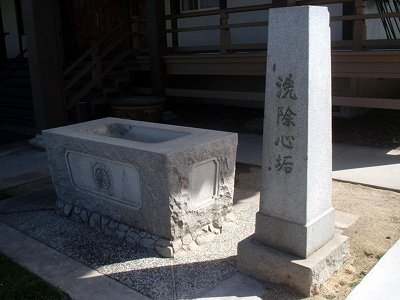
Mitarai (Clearing the grime from our mind)
Thank You
We hope this booklet gives you some ideas about our temple. Thank you for taking the time to glimpse through the material. This booklet is merely to get you acquainted with our temple and Sangha. There are changes taking place regularly. Should you have any questions, please do not hesitate to contact our ministers or office staff. We hope to see you soon.
Updated by the Archive Committee 2007
* We thank Rinban Fujimoto and Reverend Sakamoto for their assistance in editing.
